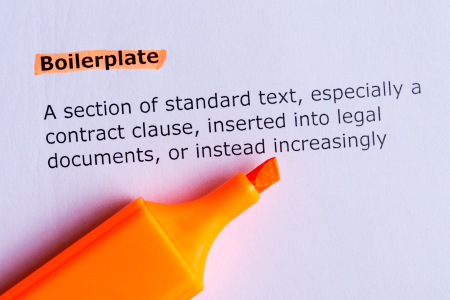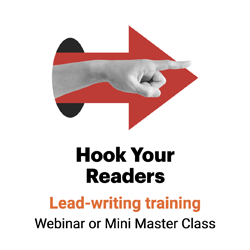Boil your company down with boilerplates
Boilerplates: Can’t live with ’em, can’t get a decent one through approvals.

What is a boilerplate in a press release?
A boilerplate is the short “About us” paragraph at the end of a release that describes your organization.
The term boilerplate dates back to the late 1800s. Then, boilermakers would stamp their company details on the end plate of a steam boiler so people would know who made it. Later, newspaper syndicates articles on steel printing plates that came to be known as boilerplates.
Today, “boilerplate” refers to any canned copy that’s ready to use over and over again. That ranges from syndicated stories to standard provisions in legal documents to generic computer code.
So how do you write an effective boilerplate? Before you write a press release, make sure your boilerplate follows these best practices:
Include just the facts, ma’am.
What goes into a good boilerplate?
To decide, think like your target audience. Ask, “What would a journalist or blogger need to know to define my company in an article or post?”
For the most part, you’ll want to stick to the 5 W’s. You might want to include:
WHOM you help. AllianceBernstein’s boilerplate, for instance, says, “For over 40 years, AllianceBernstein Investments, Inc., … has helped investors …”
WHAT you make or do. AllianceBernstein: ” … mutual funds, college savings (529) plans, retirement products and separately managed accounts.”
WHERE you’re located. List your headquarters location and summarize the rest in a phrase.
WHERE readers can find you online. To optimize your boilerplate for news portals:
- Link your company name to your homepage.
- Include the URL in parentheses after your company name
- They don’t need to know how to find you on Twitter. Link to your homepage only.
WHY you’re an industry leader. Don’t just call yourself a leader. Deliver a compelling proof point.
Rosetta Stone’s boilerplate, for instance, says:
Teaching 29 languages to millions of people over 150 countries …
And:
For the second year in a row, Fairfield Language Technologies is one of the fastest growing technology companies in Virginia as ranked by Deloitte and Touche.
You might also include:
- Your stock ticker symbol
- The year you were founded, if notable. American Express, for instance, notes that it was founded in 1850. Wylie Communications, on the other hand, doesn’t mention that it was founded in 1996.
- Your size in measures that make sense for your organization. That might be in annual revenues; assets under management; number of employees, clients, members, outlets or products sold.
What to leave out of your boilerplate
What you take out of your boilerplate is almost as important as what you put in. Drop the:
1. Vapid marketing slogans. Skip the marketing fluff. Even though, according to Kevin Dugan, marketing communicator and blogger for Bad Pitch Blog, it “reads like brand poetry to marketing, legal and the CEO.”
If the reader can’t tell what you make or what industry you’re in after reading your boilerplate, go back to go. “Innovative investment solutions from a diverse line of investment vehicles,” for instance, gets me nowhere.
2. Adjectives and other hype. Here’s a boilerplate that’s virtually breathless with self-congratulations:
Tellabs’ boilerplate, for instance, says: “… 43 of the top 50 global communications service providers choose our mobile, optical, business and services solutions.”
Show me your awards and recognition. Don’t tell me about them.
3. Footnotes. Shoot the lawyers if they even suggest them.
Also, drop the calls to action. This is no place for your 1-800 number.
Press release boilerplate template
There’s no one way to write a boilerplate. But here’s a formula I use, based on an elevator pitch model that Mark LeBlanc created for small business owners:
Here’s how it looks when I fill in the blanks:
Keep boilerplates short.
I’ve seen boilerplates that are as long as 400 words. People: That’s too long for the average news release, let alone the boilerplate.
“Freud could have a field day with the overcompensation that leads to boilerplate abuse.”
— Kevin Dugan, marketing communicator and blogger, in Bad Pitch Blog
Instead, keep your boilerplate to 100 words or less. Even better: Keep it under 50 words.
Why so short? When your boilerplate is too long, you:
- Overpay for distribution. BusinessWire charges a base rate for the first 400 words of a release and an additional fee for every 100 words after that. Long boilerplates can break the budget.
- Irritate your audience. “Editors/journalists across the board … agreed that pitches [and releases] should have less boilerplate,” according to a Cision’s study (PDF).>
- Risk public humiliation. See Bad Pitch Blog’s piece about a 261-word boilerplate under a 169-word release. And here’s a Bad Pitch Blog rant about a 178-word boilerplate.
TheSteelAlliance’s boilerplate, for instance weighs in at just 44 words:
Anything missing? I’d probably add the headquarters location and the organization’s URL.
Avoid this approach. Embassy Suites’ boilerplate is 174 words long. (Embassy Suites also includes Hilton Hotels’ 71-word boilerplate, bringing the total to 245 words.)
You could cut this in half by summarizing the laundry list of amenities, dropping the reservation line and linking to the honors details.
Polish your boilerplate copy.
Whatever you do, make sure you write a great boilerplate. Every press release template and effective press release includes one.
Your lawyers and leadership team demand it. So do your press release distribution services. Maybe they support brand awareness? They support search engines, social media and content marketer content.
So press release boilerplates aren’t going anywhere.

Leave a Reply